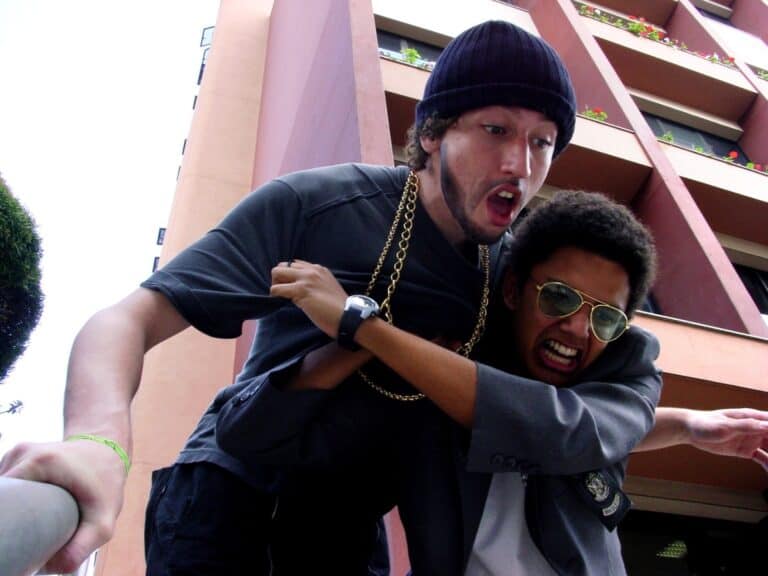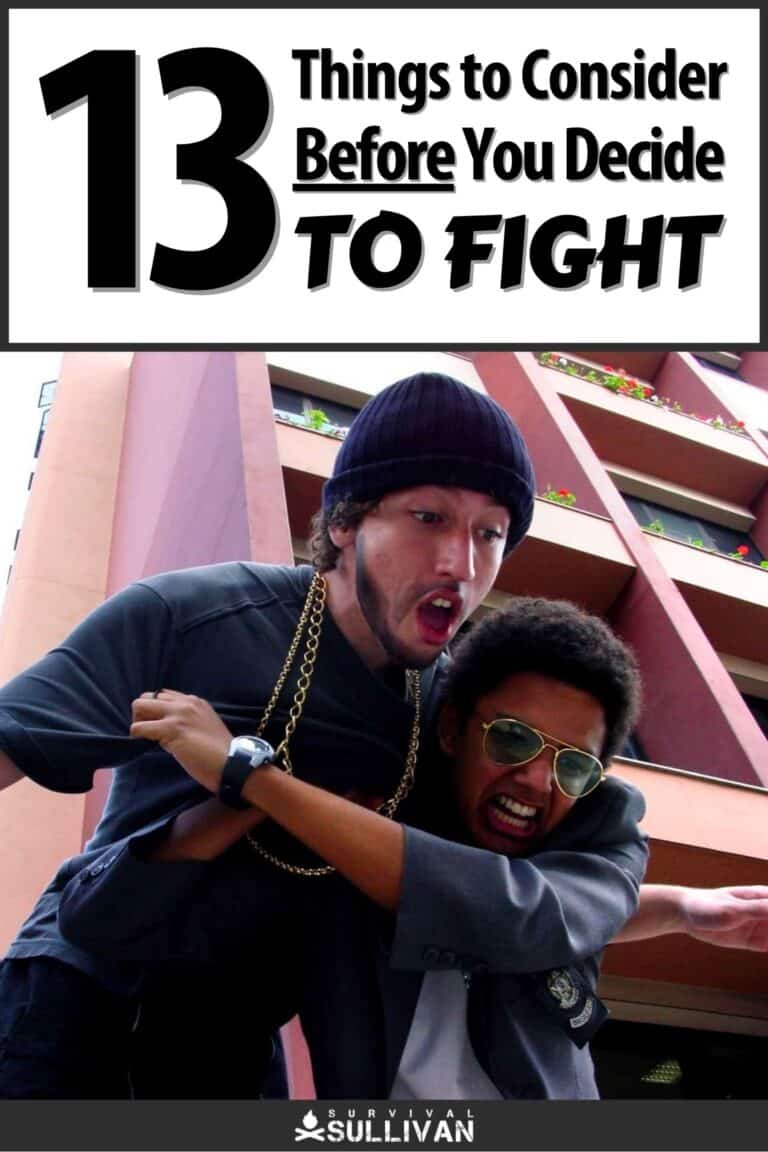Fighting is, in general, a very risky business. You have no idea what’s going to happen and, unlike in a Dojo where you have rules and safety equipment, the street is an unpredictable and messy arena.

As such, street fights are rarely, if ever, clean, and fair; they get messy very, very quickly and people get hurt.
There are no rules (beyond your own moral/ethical views), no weight classes, age groups, or referees. There’s also little control over who gets involved.
In a Dojo, or tournament setting, the sparring matches are limited to the two people on the mat for that round.
Spectators are a safe distance away, often with something to keep them off the competition floor.
Where are those limitations/safety nets in a street fight? They’re not there, this means that all and sundry can get involved, and what started out as a one-on-one fistfight becomes a barroom brawl!
The decision to fight is not one to be made lightly, there are serious consequences – irrespective of the outcome – that need to be considered.
With that in mind, we’re going to look at some things you should consider before you decide to scrap with someone.
Defense on Principle Isn’t Great
Back in 2011, I was doing horseback riding lessons and my very first instructor had a son who was about 13 or 14.
The one day he arrives with his mom and his right hand is bandaged and it looks like it’s been through a grinder.
I ask him about it, and he tells me he was mugged by three guys at knifepoint a few days earlier and had grabbed the blade of the knife…I wish I were making that up.
His hand was cut up badly and they took his phone, watch, wallet, and a few other things anyways.
When I asked him why he didn’t just give them what they wanted – because that’s what most sensible people do – he said, and I quote: “because it was my stuff”.
Defending your personal property on the principle that it’s yours and nobody has the right to take it from you is fine and dandy – until it puts your life at risk.
Your phone, watch, wallet, tablet, whatever it is, it can be replaced; your life cannot be replaced! With that said, let’s start this list off by discussing risk in a bit more detail.
1) Risk to Life and Limb
This is something that is routinely overlooked – especially by teenagers and young adults.
When you get into a street fight, you risk serious injury. You’ve got no idea if the other person (your opponent) is going to be alone or with friends, you don’t know if he’s got a weapon on him.
Even if he doesn’t have a weapon initially, he can and will improvise one!
Anything and everything in the street from bricks to bottles to bits of pipe can be used as a weapon and inflict serious, sometimes life-threatening injuries.
So, why do I say this aspect of fighting is overlooked? Well, simply because so many people that I’ve spoken to have said the same thing: “I’ll just do (insert technique here) and the bad guy will go away”.
It doesn’t work like that, and for some reason some people still take an unnecessary risk because they don’t want to part with something valuable to them.
I was always told that it’s best to just give up your belongings and, having seen the aftermath of someone taking that unnecessary risk, that belief is firmly in place.
2) Legal Headaches
Street fights carry significant legal repercussions in addition to the physical safety risks. Assault and battery charges are a thing, and they carry some major legal penalties.
Considering how expensive lawyers can be, it’s important to know whether or not you can afford the hassle of a fight’s aftermath.
3) Medical Repercussions
In addition to the legal headaches, you have to consider the medical repercussions involved with fighting.
The decision made by the kid in the story nearly cost him a few fingers – and that’s just on the physical side of things.
What about the psychological wounds that violent encounters can leave?
These are often traumatic experiences with sizable medical bills attached, can you afford to deal with that?
4) Effects on those Around You
Before you decide to fight, you should consider how your actions will impact other people (i.e. friends and family).
Nobody wants to be called to the hospital to see a loved one in critical condition, it’s not pleasant.
Likewise, watching you go to prison for a fight is probably not high on your family’s to-do list.
5) Can the Situation be Resolved Peacefully?
Oftentimes a street fight is the result of frustration and/or a bruised ego, but can these situations be resolved peacefully before they come to blows?
The answer, most of the time, is yes, you can resolve a situation without having to fight.
With that in mind, look at your own situation and try to resolve the situation peacefully. Anytime you can walk away from a fight without throwing a punch is a victory.
6) Why Do you Want to Fight?
Kind of a silly question, isn’t it? Silly or not, the question is a valid one.
If a situation can be resolved peacefully, then why do you want to hurt someone? Are they physically threatening you or did they just bruise your ego?
People seem to be very fond of the phrase: “better to be judged by twelve, than carried by six” and I can definitely see where they’re coming from, but wouldn’t you rather be neither one of those?
7) Are you Fit Enough to Fight?
Your body’s physical condition/health is a major factor when it comes to fighting. A fight will depend on your strength and endurance.
If you can’t outrun your attacker and you’re forced to fight back, it will take an awful lot of strength and endurance.
The last thing you want is to run out of fuel halfway through the fight.
If your attacker is stronger than you and they can fight for longer than you…well…it’s not going to end well.
Now, I know what you’re thinking: “I’ll just run!”
Great, how fast can you run? How long can you maintain that pace? What if you’ve got someone else with you (i.e. wife, girlfriend, daughter, etc.) that you have to protect?
A 6-year-old kid isn’t going to be able to run far for a long period.
Another problem with running, is that you can’t see what’s behind you – your eyes are in the front of your head – and you’ve given the bad guy your back and made yourself vulnerable.
8) Does the Other Person have a Weapon?
Unfortunately, weapons are a serious risk when it comes to fighting. You need to consider whether your opponent has a weapon.
If they do have a weapon, what is it? Whatever the weapon is, they can do a lot of damage, but each weapon will have different mechanics.
Knives and firearms can be devastating, so can a baseball bat or frying pan; none of these weapons function in quite the same way (although, bats and frying pans can cause serious injuries if swung hard enough), and each has a different level of risk involved.
This is why many self-defense instructors tend to discourage trying to disarm an attacker; you can get very seriously injured and people around you can be seriously injured.
This is especially true since there are numerous ways to conceal a weapon and improvisation means that anything can be used as a weapon.
9) Is your Aggressor Alone or with Friends?
I’ve done a few multiple attacker drills over the time that I’ve been training, and it’s never been a pleasant experience.
Fighting in a one-on-one encounter is one thing but fighting more than one person at a time is much more complicated.
So, is the guy who’s picking a fight with you alone or does he have a few friends nearby?
This is something you need to keep in mind, occasionally bad guys will have a few colleagues around to make sure they have the advantage.
10) Are there Other People in the Vicinity?
We’ve discussed the possibility of multiple attackers, but people who end up seeing the fight go down can also get hurt.
As sad as it is, people are more likely to pull out their phones to film a fight than to help put an end to the fight.
So, how do they get hurt? Well, they get caught in the crossfire of the flying fists; you throw a punch and miss your opponent – hitting an innocent bystander by accident.
There’s also what’s called the bystander effect that can also cause people to get hurt.
The bystander effect is where people are less likely to offer help if there are other people around – basically “someone else will help, I don’t need to get involved”.
Okay, so people are probably not going to help if others are around who can do it, but what about those who do help?
Well, apart from getting smacked around, the possibility of weapons makes things even trickier. This is something else to consider.
11) Source of Conflict
When it comes to fights, there’s always a trigger of some sort. People flirting with your significant other, heated arguments, and gossip/rumors are all viable triggers.
The important thing is to consider where the conflict is coming from – the source of it all.
If you’re reacting to someone flirting/talking with your spouse/significant other, why? What’s causing that reaction?
Gossip and rumors are often the source of arguments – which can become heated and get out of hand very quickly.
12) Do you KNOW What’s Going On?
Building on the last point, do you have all the facts of the situation?
It’s one thing if someone comes flying at you in a diner trying to knock you out but it’s something else if you’re getting involved from the outside.
That is to say, the fight didn’t have anything to do with you initially, you just want to get involved for whatever reason (i.e. to help a friend).
If someone is starting rumors/gossip and using that to start a fight, are they really people that you can trust to be unbiased when it comes to telling you what’s going on?
If you’re the one who’s going to be getting into the fight, how do you know what you’ve been told is accurate?
13) Is there Someone who Can Help you Avoid the Fight?
I mentioned before how teens and young adults tend to overlook the risks of fighting but another aspect of fighting that they often overlook is adult assistance.
Kids in high school have issues regarding their image – they want to be the cool kids with all the perks that come with being a part of that clique.
They get into arguments which become fights and often they end up with either the school principal or a guidance counsellor – in some cases they may end up with both.
Whether you’re in school or not, consider whether there’s someone you can talk to about the fight – ideally before it happens – and try to avoid it entirely.
If you’re in school, then an adult’s assistance/guidance can help you avoid unnecessary trouble and talking with your parents/guardians about the fight will also help.
There are Many Other Factors
Street fights are dangerous and unpredictable, this means that the factors to consider may change depending on the scenario/environment.
De-escalation and avoidance are your best friends in these situations, and you need to think carefully and consider all your options before choosing to fight.
Now, the factors that you need to consider will change your available options – that’s obvious, right?
What matters is that you think about all of the different options available – ideally exhausting them all – before you decide to fight because at least then you can say with some certainty that you tried to avoid it and, if you end up in court, the legal system may see it that way too.
I hope this article helps out in some way, that you enjoyed reading it and found it informative. As always, thanks for reading and I’ll see you for the next one. Until then, take care and stay safe!


Greg spent much of his younger years camping and hiking. Greg grew up on a small farm with lots of livestock such as cows, horses and chickens. He’s good with a bow and arrow, is a huge knife enthusiast, and has a blackbelt in Taekwondo.
